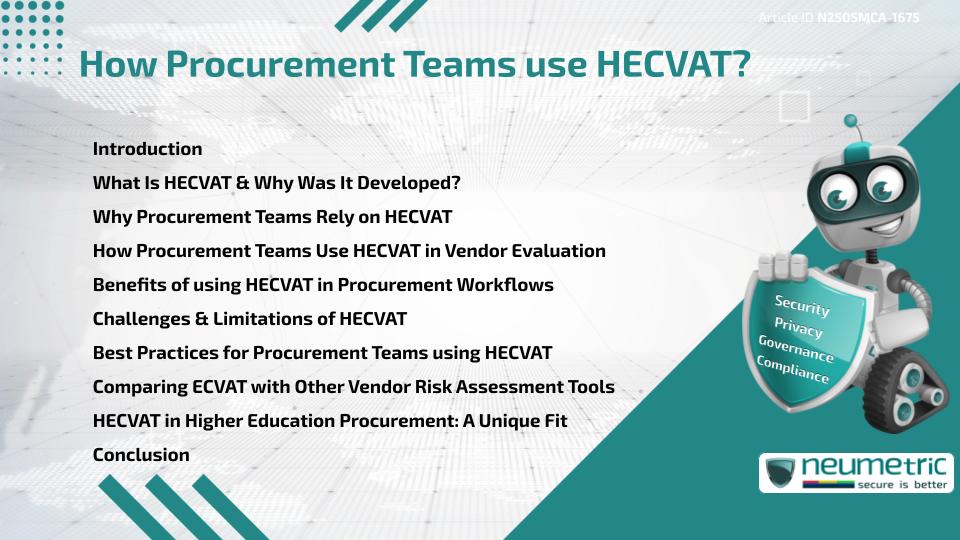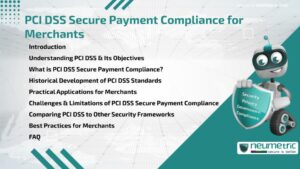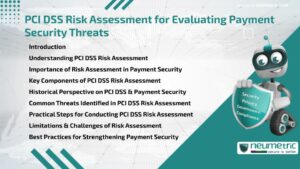Table of Contents
ToggleIntroduction
Vendor selection in today’s data-sensitive world is more than just comparing price quotes. Procurement professionals must also consider CyberSecurity Risk, Privacy & Compliance. That’s where the Higher Education Community Vendor Assessment Toolkit [HECVAT] becomes essential. This standardised Framework is especially popular in academic & research settings. But how procurement teams use HECVAT extends beyond universities—it’s now a critical part of evaluating Third Party Risk across various institutions.
In this article, we explore how procurement teams use HECVAT, its origins, its practical role in Vendor evaluation & its advantages & drawbacks.
What Is HECVAT & Why Was It Developed?
HECVAT is created by the Higher Education Information Security Council [HEISC], with an aim to organise Vendor Security Assessments. Before HECVAT, each institution used different questionnaires, making comparisons slow & inconsistent. HECVAT solved this by offering a central, unified template for evaluating a Vendor’s approach to Data Security & Compliance.
This toolkit comes in multiple versions such as HECVAT Full, HECVAT Lite & HECVAT On-Premise to suit different levels of Vendor complexity. More information about the origins & structure of HECVAT can be found on Educause’s official HECVAT page.
Why Procurement Teams Rely on HECVAT
Procurement professionals often manage dozens of Vendor relationships. Ensuring each Vendor meets Security Standards without drowning in paperwork is a challenge. That’s why HECVAT is so valuable. It standardises how questions are asked & answered, saving time & allowing for more confident decision-making.
When procurement teams receive responses based on HECVAT, they can quickly assess Risks using a format they understand. This consistency builds internal trust between Security, Legal & Business teams, who all need to approve a Vendor.
How Procurement Teams Use HECVAT in Vendor Evaluation
So, how procurement teams use HECVAT in daily workflows? Here’s how it works:
Step 1: Issuing HECVAT During RFP or RFQ
When issuing a Request for Proposal [RFP] or Request for Quote [RFQ], procurement teams often attach the appropriate HECVAT version. This signals to Vendors that CyberSecurity readiness is a key selection factor.
Step 2: Reviewing Responses for Gaps
Once completed HECVAT forms are returned, teams examine them to identify gaps such as missing Encryption Standards or poor Access Controls. This helps isolate high-Risk Vendors.
Step 3: Coordinating With Security Teams
Procurement does not work in isolation. Security teams help validate responses. Any red flags in a HECVAT form often lead to follow-up questions or a request for a Security remediation plan.
Step 4: Making Informed Purchasing Decisions
By combining pricing, service quality & HECVAT results, procurement teams make informed decisions. HECVAT acts like a scorecard, adding a Security layer to the final Vendor ranking.
Benefits of using HECVAT in Procurement Workflows
There are several benefits to using HECVAT, particularly in higher education & research organisations:
- Saves time: A pre-built questionnaire reduces the need for custom assessments.
- Enhances clarity: Teams get responses in a format they know well.
- Reduces Vendor fatigue: Vendors prefer HECVAT because they can reuse responses for multiple clients.
- Improves Compliance: Helps ensure Vendors meet FERPA, HIPAA or GDPR requirements.
Challenges & Limitations of HECVAT
While powerful, HECVAT has its limits.
- Not always Vendor-friendly: Small startups may find it overwhelming.
- Requires training: Procurement teams must be trained to interpret technical responses.
- Not one-size-fits-all: Some industries outside higher education may find the questions irrelevant
It’s important to remember that HECVAT works best when paired with other procurement tools & Policies.
Best Practices for Procurement Teams using HECVAT
To make the most of HECVAT, procurement professionals should:
- Choose the right version of HECVAT based on Vendor complexity.
- Engage IT Security early in the process.
- Educate Vendors about why HECVAT matters.
- Track HECVAT responses over time to monitor Risk trends.
- Include HECVAT as a Standard part of every RFP process.
These practices ensure that how procurement teams use HECVAT is efficient & aligned with internal goals.
Comparing HECVAT with Other Vendor Risk Assessment Tools
There are other tools like SIG [standardised Information Gathering] Questionnaire & CAIQ [Consensus Assessments Initiative Questionnaire]. However, HECVAT is more tailored to academic & public-sector environments. Its structure makes it easier for teams unfamiliar with deep CyberSecurity concepts to make sense of Vendor responses.
HECVAT in Higher Education Procurement: A Unique Fit
HECVAT’s original focus was higher education, where procurement often intersects with research, student data & grant Compliance. In this setting, how procurement teams use HECVAT isn’t just a convenience—it’s often a requirement for Risk Assessments tied to federal funding or Internal Audit standards.
This context makes HECVAT almost a default in university procurement offices, forming part of broader HECVAT-aligned IT Governance.
Conclusion
HECVAT has become a practical & trusted tool for procurement teams tasked with managing Third Party Risk. Its structured approach removes the guesswork from Vendor Security evaluations & fosters better collaboration between procurement, IT & legal departments. By offering a clear & consistent method for assessing Vendors, HECVAT reduces uncertainty, improves Compliance & strengthens institutional resilience. Understanding how procurement teams use HECVAT allows organisations to streamline decision-making while prioritising Data Protection—a crucial balance in today’s digital procurement landscape.
Takeaways
- HECVAT was developed to standardise how institutions assess Vendor CyberSecurity Risks.
- Procurement teams use HECVAT throughout the Vendor evaluation lifecycle.
- Its benefits include time-saving, clear communication & Compliance assurance.
- Limitations include complexity for small Vendors & the need for trained staff.
- HECVAT is most effective when integrated with other procurement & IT workflows.
FAQ
What is HECVAT used for in procurement?
HECVAT helps procurement teams evaluate a Vendor’s CyberSecurity practices using a standardised questionnaire to identify Risk areas.
Why is HECVAT important for procurement teams?
It simplifies complex Vendor evaluations by creating a consistent format for assessing Risk, which helps teams make informed decisions.
How do Vendors respond to HECVAT?
Vendors complete the HECVAT form & return it with their technical, operational & Compliance details, which are then reviewed by procurement & IT.
Is HECVAT mandatory for all Vendors?
Not always. While often required in higher education, private organisations may choose to adopt HECVAT selectively based on Risk levels.
How long does it take to review a HECVAT?
Depending on Vendor complexity, reviews may take from a few hours to several days, especially when Security red flags are identified.
Can HECVAT replace other Security Assessments?
Not entirely. HECVAT is a strong baseline but works best when supplemented with Penetration Testing or audits.
What are common mistakes in using HECVAT?
Using the wrong version, skipping IT input or failing to follow up on Vendor gaps are common pitfalls in how procurement teams use HECVAT.
Who should be involved in HECVAT evaluation?
Procurement, IT Security, legal & sometimes Compliance officers should all be part of the review process.
References
Need help?
Neumetric provides organisations the necessary help to achieve their CyberSecurity, Compliance, Governance, Privacy, Certifications & Pentesting goals.
Organisations & Businesses, specifically those which provide SaaS & AI Solutions, usually need a CyberSecurity Partner for meeting & maintaining the ongoing Security & Privacy needs & requirements of their Clients & Customers.
SOC 2, ISO 27001, ISO 42001, NIST, HIPAA, HECVAT, EU GDPR are some of the Frameworks that are served by Fusion – a centralised, automated, AI-enabled SaaS Solution created & managed by Neumetric.
Reach out to us!





